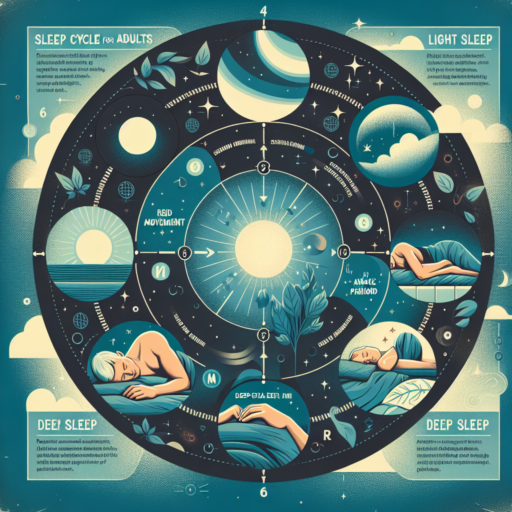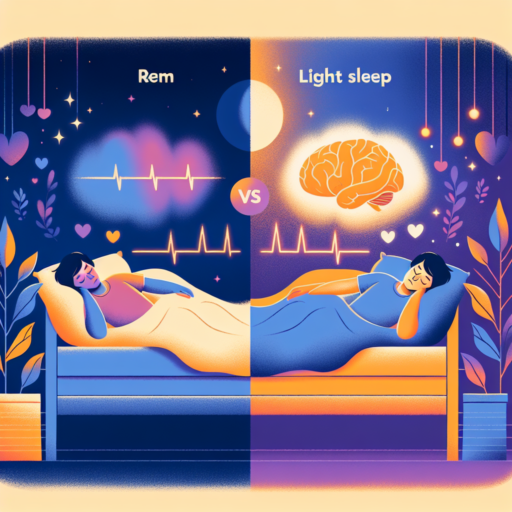Understanding the Normal Sleep Cycle: An Overview
The normal sleep cycle is a critical component of human health, playing a crucial role in our physical and mental wellbeing. Comprehending this cycle and its phases is vital for recognizing patterns that contribute to restful sleep and identifying potential disruptions. Our bodies operate on a 24-hour cycle known as the circadian rhythm, which dictates our sleep-wake patterns among other bodily functions.
During a typical night’s sleep, an individual goes through various stages, which include both REM (Rapid Eye Movement) and non-REM phases. Non-REM sleep consists of three stages, starting with light sleep and transitioning into the deepest sleep. The cycle then moves into the REM phase, which is characterized by rapid eye movement, increased brain activity, and vivid dreams. This cycle repeats itself multiple times throughout the night, with REM phases getting longer as the night progresses.
Key Phases of the Sleep Cycle
- Stage 1: Transitional phase between wakefulness and sleep.
- Stage 2: Light sleep, where heart rate and breathing regulate, and body temperature drops.
- Stage 3: Deep sleep, essential for physical recovery and growth hormone release.
- REM Sleep: Brain activity increases, fostering learning, memory, and mood regulation.
Understanding these cycles is not just academic; it can profoundly impact our day-to-day functionality and overall health. Disruptions in these cycles, such as those caused by sleep disorders like insomnia or sleep apnea, can lead to significant physiological and psychological issues. Hence, gaining insight into the structure and function of our sleep cycles is a step toward enhancing our sleep quality and, by extension, our life quality.
The Stages of a Healthy Sleep Cycle
Understanding the stages of a healthy sleep cycle is crucial for achieving optimal health and wellness. The sleep cycle consists of four primary stages, each playing a vital role in restoring and rejuvenating the body and mind.
The Four Main Stages of Sleep
- Stage 1: This initial phase marks the transition from wakefulness to sleep. It’s a light sleep stage where you can be easily awakened. This stage usually lasts for several minutes.
- Stage 2: As you move into stage 2, your heart rate and breathing start to slow down, and your muscles relax. This period of light sleep precedes the deeper sleep stages and constitutes the majority of your sleep cycle.
- Stage 3: Often referred to as deep sleep, stage 3 is when the body undergoes significant repair and restoration. During this time, tissue growth and repair occur, important hormones are released, and energy is replenished. This stage is critical for physical recovery and health.
- REM Sleep: The final phase of the sleep cycle is known as REM (Rapid Eye Movement) sleep. This stage is characterized by rapid movements of the eyes, increased brain activity, and vivid dreams. REM sleep plays a key role in cognitive functions such as memory, learning, and emotional regulation.
Each stage of the sleep cycle serves a distinct purpose in maintaining physical health, emotional well-being, and cognitive performance. Cycling through these stages multiple times throughout the night is essential for waking up feeling rested and refreshed. It’s important to understand these stages to appreciate the complexity of sleep and its profound impact on overall health.
How Many Hours of Sleep Do You Really Need?
Understanding the optimal amount of sleep required can significantly impact your overall health and productivity. The amount of sleep an individual needs varies greatly with age. For instance, while newborns may require up to 17 hours of sleep a day, adults generally need between 7 to 9 hours. This variance sheds light on the importance of tailoring sleep schedules to individual needs rather than adhering to a one-size-fits-all approach.
Age-specific sleep recommendations offer a useful guideline for determining how many hours of sleep you might need. Adolescents, for example, who are in a critical period of growth and development, require about 8 to 10 hours of sleep each night to function at their best. As we transition into adulthood, the range slightly decreases, underscoring the role of sleep in cognitive function, emotional well-being, and general health maintenance.
It’s critical to note that while the quantity of sleep is important, the quality of sleep plays an equally crucial role in ensuring restorative rest. Factors such as sleeping in a dark, quiet, and cool environment can enhance sleep quality. Paying attention to sleep hygiene practices can help maximize the health benefits of the hours spent sleeping. Listening to your body’s needs and adjusting your sleep schedule accordingly can lead to improved energy levels, mood, and overall health status.
Recognizing the Signs of a Disrupted Sleep Cycle
Understanding and recognizing the signs of a disrupted sleep cycle is crucial for maintaining optimal health and well-being. Our bodies rely on consistent sleep patterns to function properly, yet numerous factors can interrupt this cycle, leading to potential health issues. Identifying these signs early can help in taking necessary steps for a more restful and rejuvenating sleep.
Common Signs of Sleep Disruption
- Difficulty falling asleep: Lying awake for long periods before finally dozing off is a clear indicator of a disrupted sleep cycle.
- Frequent awakenings: Waking up several times during the night and struggling to go back to sleep contributes to inadequate sleep quality.
- Daytime fatigue: Feeling excessively tired during the day despite spending an adequate number of hours in bed is a sign that the sleep was not restorative.
In addition to these signs, other symptoms such as mood swings, decreased cognitive function, and reliance on caffeine or other stimulants to remain alert are also indicative of a disrupted sleep cycle. Being mindful of these signs and assessing one’s sleep habits can be the first step towards improving sleep quality and overall health.
Tips for Achieving and Maintaining a Normal Sleep Cycle
Establishing and maintaining a normal sleep cycle is crucial for overall health and well-being. The key to achieving this lies in understanding and implementing effective strategies. One fundamental tip is setting a consistent sleep schedule. By going to bed and waking up at the same time every day, your body’s internal clock can adjust, making it easier to fall asleep and wake up naturally.
Another tip is creating a bedtime routine that signals to your body it’s time to wind down. This could include activities such as reading a book, taking a warm bath, or practicing relaxation exercises. Avoiding screens, such as your phone, tablet, or TV, at least an hour before bedtime is also beneficial, as the blue light emitted can interfere with your sleep cycle.
Lastly, optimizing your sleep environment can have a significant impact on your ability to maintain a normal sleep cycle. Ensure your bedroom is quiet, dark, and at a comfortable temperature. Investing in a good quality mattress and pillows can also promote better sleep. Regular exercise during the day can help you fall asleep more easily at night, but try to avoid vigorous activity close to bedtime.
No se han encontrado productos.
The Role of REM and Non-REM Sleep in Your Sleep Cycle
Understanding the intricate dance between Rapid Eye Movement (REM) and Non-Rapid Eye Movement (Non-REM) sleep phases is crucial for decoding the mysteries behind a restful night. These stages form the very foundation of what we’ve come to understand about our sleep cycle, playing distinct yet interconnected roles in our health and well-being.
During the initial stages of sleep, your body transitions through various phases of Non-REM sleep, each progressively deeper and more restorative. Non-REM sleep is characterized by a decrease in bodily functions such as heart rate, breathing, and brain activity. This phase is critical for physical recovery, cellular repair, and growth. It constitutes the bulk of your sleep cycle, ensuring that your body conserves energy and rebuilds tissues after the day’s activities.
As the night progresses, REM sleep takes the stage, marked by a stark contrast in physiological responses. During REM, your brain activity surges, mimicking patterns observed while awake. This phase is famously associated with vivid dreams due to the increase in brain activity. REM sleep plays a pivotal role in memory consolidation, emotional processing, and cognitive function. It supports neural connections and is essential for learning and day-to-day memory function.
Transitioning seamlessly between Non-REM and REM sleep cycles is vital for a holistic restorative sleep experience. Each cycle lasts about 90 minutes, with the proportion of REM sleep increasing in the latter half of the night. Understanding this delicate balance helps highlight the importance of both REM and Non-REM sleep in maintaining mental health, physical health, and overall quality of life. Your sleep cycle is a complex, yet beautifully orchestrated process that is fundamental to your well-being.
How Age Affects Your Sleep Cycle: From Infants to Adults
Understanding how age influences your sleep cycle is pivotal in recognizing the changes your body undergoes as you move from infancy through to adulthood. The amount of sleep we need and the way our bodies manage sleep evolves, highlighting the necessity of adapting our sleep habits to support health and well-being at every stage of life.
Infancy and Toddler Years
In the earliest years of life, infants require significantly more sleep than adults, with newborns sleeping as much as 16 to 18 hours per day, distributed over short periods throughout the 24-hour day. This extensive need for sleep supports rapid mental and physical growth. As toddlers, the total sleep requirement decreases slightly but remains high, with a need for 11 to 14 hours of sleep, including naps, to support their quickly developing bodies and brains.
Childhood to Adolescence
As children grow, the amount of sleep needed continues to adjust. School-age children should aim for 9 to 11 hours of sleep each night to foster learning and memory retention. However, as children move into adolescence, circadian rhythms shift, making it natural for teenagers to prefer staying up later at night and sleeping in later in the morning. Despite this shift, teenagers still require about 8 to 10 hours of sleep for optimal health, though many fail to meet this requirement due to various social and educational pressures.
Adulthood
Entering adulthood introduces new challenges to maintaining a healthy sleep cycle, including work commitments, stress, and family responsibilities. While adults technically need less sleep than children—7 to 9 hours is the ideal—for many, achieving this can be difficult. The quality of sleep also becomes a crucial factor, with many adults experiencing disruptions in sleep patterns or sleep disorders that affect the restorative value of sleep. Adapting to these changes and prioritizing sleep hygiene can play a significant role in managing health and productivity.
Common Sleep Disorders and Their Impact on Sleep Cycles
Sleep disorders are a significant concern for many, affecting a large portion of the population globally. These conditions can severely disrupt an individual’s sleep cycle, leading to a range of health issues. Understanding these disorders and their impact is crucial for managing sleep health.
Insomnia: The Challenge of Falling Asleep
Insomnia is perhaps the most widely recognized sleep disorder, characterized by difficulty falling asleep, staying asleep, or experiencing non-restorative sleep. This condition can lead to daytime sleepiness, fatigue, and reduced energy levels, making even simple daily tasks feel overwhelming. Insomnia often creates a vicious cycle of sleep anxiety, where worry about sleep leads to even greater difficulty falling asleep.
Sleep Apnea: Disrupted Breathing During Sleep
Sleep apnea is another common disorder that impacts sleep quality and overall health. It is marked by pauses in breathing or shallow breaths while asleep. These interruptions can occur hundreds of times a night, significantly affecting the sleep cycle and leading to excessive daytime sleepiness. One of the most concerning impacts of sleep apnea is its link to cardiovascular problems, including high blood pressure and heart disease.
Restless Legs Syndrome (RLS): The Urge to Move
Restless Legs Syndrome, or RLS, is a sleep disorder that causes an irresistible urge to move the legs, often due to uncomfortable sensations. These sensations typically occur in the evening or during periods of inactivity, making it difficult to fall asleep. RLS can lead to a significant reduction in sleep quality and disturbed sleep patterns, impacting an individual’s overall health and well-being.
Implementing a Sleep Schedule to Promote a Normal Sleep Cycle
Maintaining a normal sleep cycle is crucial for both physical and mental health. Creating and sticking to a sleep schedule can significantly promote a healthier sleep cycle, helping you fight off insomnia and improve your daytime alertness. Synchronizing your internal clock with your lifestyle demands is the first step towards achieving restorative sleep and enhancing overall wellbeing.
To start, it’s essential to determine a fixed wake-up time. Your body thrives on routine, and by waking up at the same time every day, you help regulate your body’s internal clock, which can lead to improvements in falling asleep more naturally at night. This consistency is key, even on weekends or days off, preventing disruptions in your sleep pattern and promoting a more natural sleep-wake cycle.
Limiting exposure to blue light from screens before bedtime is another crucial element in fostering a normal sleep cycle. The blue light emitted by phones, tablets, and computers can interfere with your body’s ability to produce melatonin, the hormone responsible for regulating sleep. Opting for activities such as reading a book or practicing relaxation techniques instead of screen time can help signal your body that it’s time to wind down for the night.
Lastly, establishing a pre-sleep routine or ritual is beneficial. Whether it includes taking a warm bath, meditating, or light stretching, these activities can act as a signal to your body that bedtime is near, thereby preparing you physically and mentally for sleep. Such practices not only help in falling asleep faster but also in enhancing the quality of sleep throughout the night.




